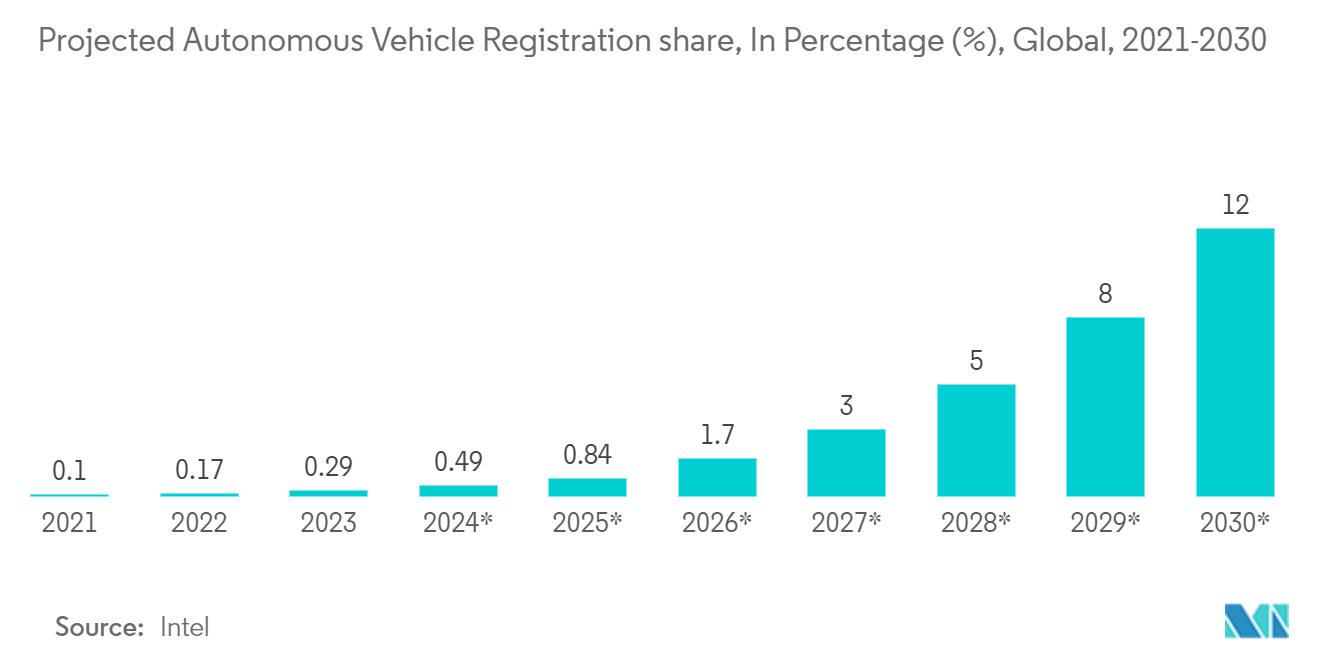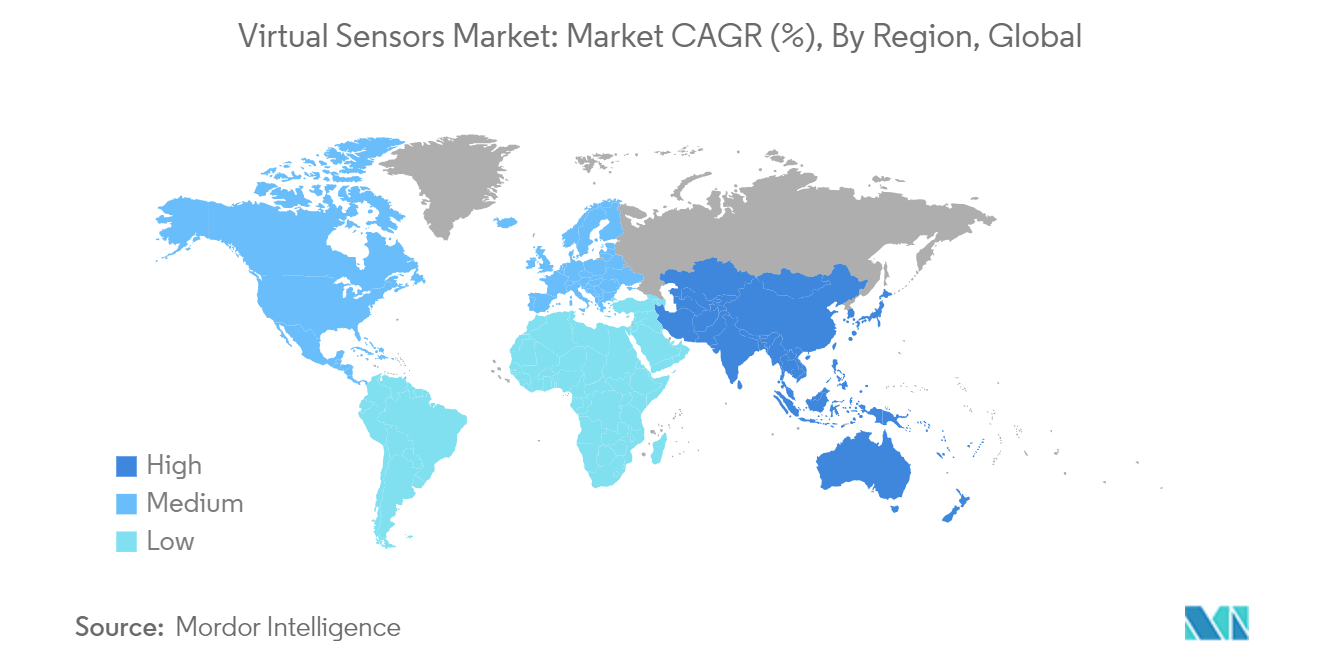Market Trends of Virtual Sensor Industry
Transportation and Automotive Industry to be the Fastest Growing End User
- The increasing usage of digital twin technology in the transportation industry is expected to drive the demand for virtual sensors. Digital twins have emerged as the most recent technological phenomenon in the transportation sector. The implementation of digital twins in supply chains is enhancing the efficiency of supply chain networks on both local and global scales. By utilizing the data, transportation companies can accurately predict their operations. Significantly, this innovative technology also generates valuable insights to enhance corporate strategies.
- Virtual sensors are increasingly becoming crucial for the automotive industry due to their wide variety of applications. The growing adoption of virtual sensors in the industry will enable the market to gain traction over the forecast period. Amidst this costly sensory inflation, adopting virtual sensors has become prevalent.
- Virtual sensors entail replacing a physical sensor with software embedded in the vehicle’s electronic control unit. The objective is to acquire essential information without needing a physical component. Numerous vehicle parts, including tires, engines, and cabins, are embedded with these virtual sensors. Virtual sensing is widely employed in automotive applications, such as passenger thermal comfort, tire pressure monitoring systems, powertrain applications, estimation of sprung mass state, and others.
- The automotive sector depends significantly on sensing technology for various functions such as safety, entertainment, traffic management, navigation, and guidance. With the advancement towards autonomous vehicles, sensing device usage is expected to grow. Despite the high cost and occasional unreliability of physical sensors in vehicles, virtual sensors are emerging as a cost-effective solution for car makers. These virtual sensors serve as a secondary safety measure to physical sensors and play a crucial role in enhancing driver assistance systems (ADAS) and ultimately achieving autonomous driving capabilities.
- The growing demand for ADAS features in the automotive industry is expected to drive the segment’s growth. Several governments worldwide are implementing various measures to boost the adoption of ADAS technology to ensure vehicle safety. Furthermore, the increasing trend of autonomous or self-driving vehicles also plays a role in expanding the market. As an illustration, Intel predicts worldwide car sales will exceed 101.4 million units by 2030, with autonomous vehicles projected to make up approximately 12% of car registrations by the same year.
- Furthermore, Artificial Intelligence (AI) has become vital in various industries, including the automotive sector. A significant innovation in this field is the creation of advanced driver assistance systems (ADAS), which are designed to enhance vehicle safety and assist drivers in different driving situations. The adoption of ADAS technology is increasing in countries such as Germany, China, and India, as it has the potential to reduce accidents and promote road safety. Such factors in boosting ASAD technology may present significant opportunities for the market.

Asia Pacific Expected to Witness Significant Growth
- Virtual sensors are significant in facilitating the operation of smart devices and automation. Virtual sensors are crucial in driving demand for IoT (Internet of Things) by enhancing the capabilities and functionalities of connected devices and IoT systems.
- China’s continuous technological progress and investments in Artificial Intelligence (AI) and IoT (Internet of Things) fuel the demand for the market studied. Government Initiatives like the “Made in China 2025” plan have placed a strong emphasis on advancing high-tech industries, such as IoT ((Internet of Things). This support from the government has accelerated the research and innovation in IoT, leading to its adoption in multiple sectors of the economy.
- Organizations can deploy virtual sensors on cloud infrastructure without needing dedicated hardware or physical installations, reducing the deployment time and operational costs. Cloud adoption in Japan is experiencing significant growth due to the continuous transition from on-premise to cloud-based systems and increasing demand for cloud-focused systems. For instance, in January 2024, Amazon Web Services announced its plans to invest JPY 2.26 trillion (USD 15.24 Billion) into its current cloud infrastructure in Tokyo and Osaka by 2027 to address the increasing customer demand for cloud services in Japan. According to the AWS Economic Impact Study (EIS) for Japan, this investment is projected to add JPY 5.57 trillion (USD 37.6 Billion) to Japan’s GDP.
- The automotive sector depends hugely on sensing technology for various safety-related tasks, traffic management, navigation, and guidance. Virtual sensors offer an additional layer of protection to physical sensors and play a crucial role in advancing ADAS (Advanced driver assistance systems) and, ultimately, in creating autonomous vehicles.
- The automotive sector of India has always been a reliable gauge of economic performance, as it is a crucial player in both economic growth and technological progress. ADAS (Advanced driver assistance systems) enhances vehicle safety by preventing or minimizing the impact of potential accidents and is gaining importance in the Indian automotive market. The demand for advanced safety features like ADAS is vital in the current market. For instance, in January 2024, Mobileye Global Inc. plans to provide advanced driver assistance technology for upcoming Mahindra & Mahindra Ltd vehicles to expand its presence in India’s automotive industry.
- Virtual sensors fuel demand in the aerospace and defense sector by enhancing navigation capabilities, aircraft health monitoring, and autonomous systems. Additionally, the investments in aerospace and defense smart factories drive demand for virtual sensors by enabling quality control, predictive maintenance, and supply chain integration. For instance, In February 2024, GE Aerospace declared that it would be investing SGD 15 million (USD 11 Million) to upgrade the aircraft engine repair facility in Singapore into an innovative Smart Factory aimed at modernizing engine repair practices and enhancing the advancements in technology.


